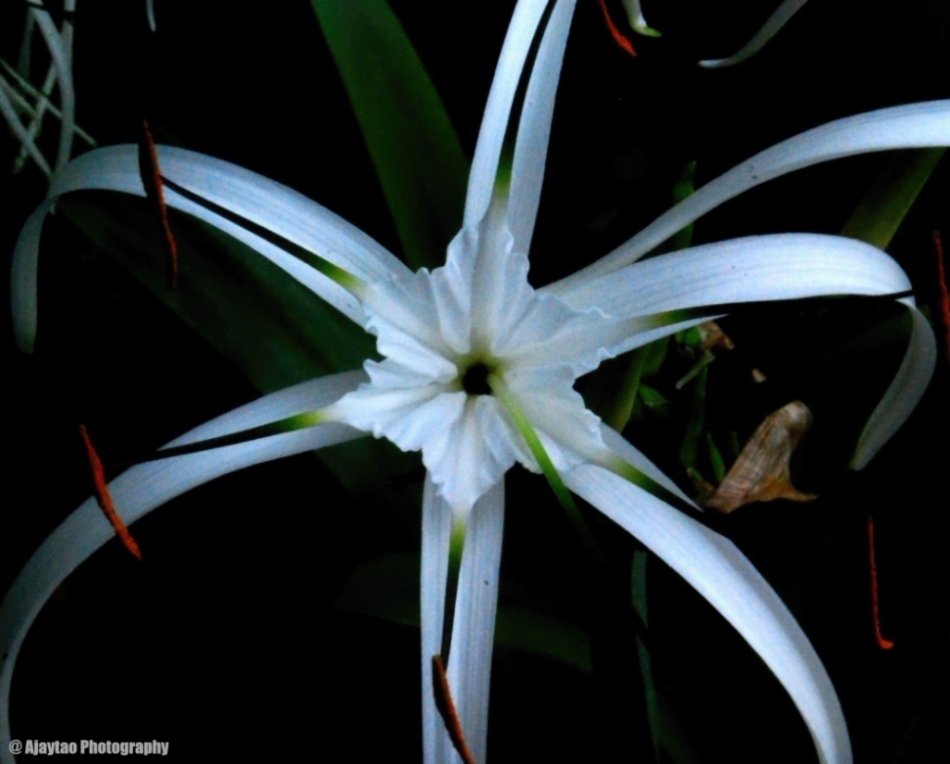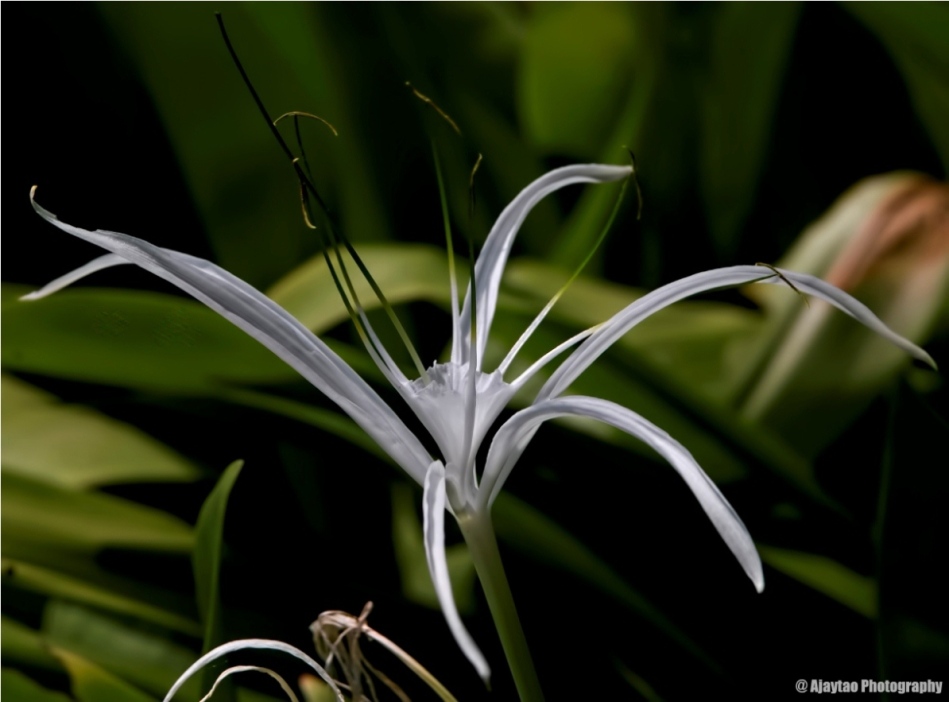Hymenocallis littoralis – Beach Spider Lily – Ajaytao
Common name: Spider lily, Beach spider lily
Botanical name: Hymenocallis littoralis
Family: Amaryllidaceae (Nargis family)
Genus: Hymenocallis
Species: H. littoralis
Hymenocallis littoralis or the Beach Spider Lily is a plant species of the genus Hymenocallis, of Latin America and widely cultivated and naturalized in many tropical countries. The flowers are delightfully fragrant, with up to 8 flowers blooming on each flower stalk at a time.
These types of lilies are sometimes called Beach Spider Lily. Natives to the tropics and subtropics, they like sun, surf and sand.
Hymenocallis littoralis is a bulbous perennial herb. It ranges in height from 60-70cm (36 inches). The bulb is 7-10 cm (3-4 inches) in diameter. With age, the bulb develops a neck that reaches 4-5 cm in diameter (up to 2 inches). The flowers are large, white, vanilla scented, and sessile. The sepals are adnate (attached to) the staminal cup. Each flower’s tube is 14 to 17 cm (5 to 7 inches) long or longer.
With long strappy leaves, most plants resemble agapanthus when not in flower. However the leaves are a darker green in colour and on most species, tend to be held slightly upright and in distinct ranks. This upright leaf arrangement catches and hides falling leaves making them the perfect low maintenance plant under trees with a high leaf drop.
Hymenocallis is a genus of some 70 species with a broad range.
Hymenocallis littoralis is native to warmer coastal regions, this includes the southern United States to the north, down through Mexico, Central America, the Caribbean and into the very north of South America, Colombia, Venezuela, Peru and Brazil. It is considered naturalized in Florida, Cape Verde, Gambia, Guinea-Bissau, Equatorial Guinea, Guinée, Central African Republic, São Tomé & Principe, Zaire (Congo-Kinshasa), Angola, Zambia, the Chagos Islands, Mauritius, Seychelles, Ogasawara ( 小笠原群島 Bonin Islands), India, Sri Lanka, Java, the Philippines, Bismark Archipelago, Fiji, Kiribati, Nauru, Niue, Samoa, Tonga, Marquesas, Society Islands, Micronesia, Hawaii, Ecuador, French Guinea and Suriname. They are so tough, undemanding and always look manicured and presentable.
Species can be divided into those that are evergreen and deciduous. The evergreen species are very widely grown in the tropics and subtropics whilst the deciduous species are much more uncommon, being mainly grown in subtropics and warm temperate areas. Many of these deciduous species were briefly included in the genus Ismene.
The exotic white flowers have extremely long, hanging petals with a central staminal cup formed from the membranes of the staminodes. The name Hymenocallis means ‘beautiful membrane’. Unlike agapanthus, they have a long flowering period and at times are so smothered in flowers you can hardly see the foliage. The biggest flush of flowers occurs at the start of the rainy season and then the flowers seem to come in flushes coinciding with very wet periods. Flowers open in the evening emitting their perfume overnight and generally last 2 to 3 days.
This may help you to remember how to take care of these beautiful lilies. Give them plenty of water throughout the growing season, add sand to the soil for fast drainage and find a spot where they’ll get several hours of bright, filtered light.
Humidity: Average room humidity
Temperature: Warm 70-85°F, 21-29°C during active growth; minimum winter temperature of 60°/16°C
Soil: 3 parts all-purpose potting mix: 1 part coarse sand
Fertilizer: Feed every 2 weeks in spring and summer with a balanced liquid fertilizer diluted by half.
Propagation: Division of bulbs. Separate offsets from the parent bulb in spring and pot them up. Water newly potted bulbs sparingly for the first month or until you see new growth.Overwintering spider lilies indoors will protect this frost-tender plant.
To get the best from your plants, divide them every 5 to 10 years and replant in freshly dug soil enriched with compost, ground rock mineral fertiliser and composted animal manure. These plants look great ‘en masse’ so plant out large numbers for some spectacular displays. Foliar feed plants under vigorous trees.
Repot in spring when you see new growth, and only when it gets too crowded, probably every 4 years or so. This tropical lily flowers best when potbound.
Hymenocallis littoralis is often grown as an ornamental. It requires sunlight to partial shade for proper growth and blooms from mid-summer to late autumn with white flowers. It may be grown aquatically.
Ajaytao Photography




Nice blog, nice pictures. We stay in touch!
LikeLiked by 1 person
May 8, 2014 at 1:10 am
Thank you so much dear 🙂
LikeLike
May 8, 2014 at 8:29 am
Love your new blog, Ajay. 😀
LikeLike
May 8, 2014 at 7:33 pm
Oh thank you so much dear 🙂
LikeLike
May 8, 2014 at 7:33 pm
Reblogged this on Oyia Brown.
LikeLike
May 8, 2014 at 8:47 pm
I’ve been longing to shoot these but so far have been unable.
LikeLike
May 9, 2014 at 9:37 pm
Oh dear your pictures are great
they a beauty to watch 🙂
thank you dear 🙂
LikeLike
May 9, 2014 at 9:45 pm
“Feed every two weeks…”?? You mean I can only eat them EVERY TWO WEEKS!!?? BUT I’LL STARVE!” *(tail flap)*
LikeLike
May 9, 2014 at 11:59 pm
okay thanks dear 🙂
LikeLike
May 10, 2014 at 12:21 am
*{pout}*
LikeLike
May 10, 2014 at 11:26 am
Oh my (pout) 🙂
thanks
LikeLike
May 10, 2014 at 4:04 pm
Reblogged this on Ajaytao 2010 and commented:
Hymenocallis littoralis – Beach Spider Lily – Ajaytao
LikeLike
May 11, 2014 at 4:50 pm
Beautiful
LikeLike
May 11, 2014 at 5:12 pm
Thank you dear
Please visit my new blog, hope you like it 🙂
https://ajaytaobotanicalblog.wordpress.com/
thank you so much dear 🙂
LikeLike
May 11, 2014 at 5:12 pm
Beautiful photo! Thank you for sharing the info of the plant, Ajay!
LikeLike
May 18, 2014 at 5:20 pm
Oh dear Amy you are so wonderful a soul dear 🙂
Thank you 🙂
LikeLike
May 18, 2014 at 6:25 pm
Your comment box found..Well. If it was a snake
it would have bit me! 😛
Your photos are amazing!
Do you mind me asking what
camera you use?
LikeLike
May 18, 2014 at 6:29 pm
I use a Nikon dear
and some old lenses which I have 🙂
Thank you so much dear 🙂
LikeLike
May 18, 2014 at 6:32 pm
I am enjoying your stunning photos:)
LikeLike
June 14, 2014 at 4:17 pm
Oh thank you so much dear Paul:)
LikeLike
June 14, 2014 at 4:22 pm